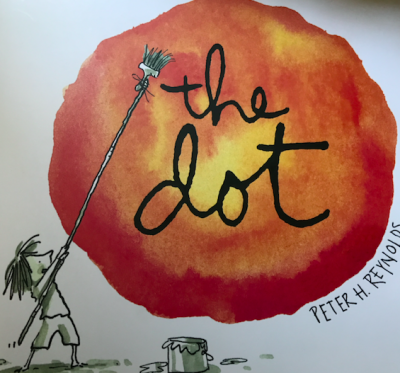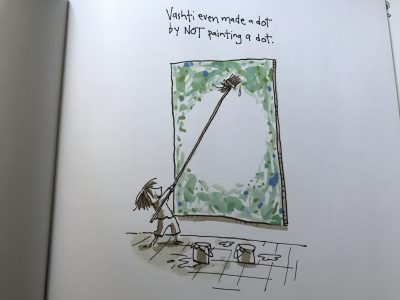Author: Peter H. Reynolds
Illustrator: Peter H. Reynolds
Publisher and year: Candlewick, 2003
Number of pages: 32 pages
Genre: Picture Book
The picture book The Dot tells a story of the power of encouragement for students. Vashti thought she could not draw, and she is very surprised to find her artwork hanging above her teacher’s desk. This artwork is just a black dot on a piece of white paper. She then got encouraged to do many more art pieces that all contain dots. Vashti’s dots made a splash at the school art show and she went on to encourage another little boy.
Across the book, each illustration and text takes up almost the same space. They seem to be supplementing each other. The author who is also the illustrator used watercolor for the book. The story starts with Vashti sitting in her chair alone after art class. She is looking down on the ground with her head resting on the back of the chair. She is facing backwards from her art tools and she seems upset. When the teacher comes in, she is still facing backwards from the desk. When the teacher asks Vashti to make a mark and see where it takes her, she still remains in the same sitting position. Red color surrounded her when she jabbed the paper in anguish. These red color seems to be implying Vashti’s frustration and even anger. But the teacher picked up the paper and looked at it carefully. She asked Vashti to sign her name. When Vashti was signing her name, those red color changed into orange colors which implies Vashti might be less angry now. Then we see the paper being framed in swirly gold and hanging above the teacher’s desk. Vashti thought she could do better and then the color changed into green. She soon opened her never-before-used set of watercolors and set to work. As the story went on, different colors surrounded Vashti as she was making more dots and went to the school art show. Several students and parents were looking very carefully at Vashti’s artworks. Vashti stands in the corner and smiled.
At the end, not only does Vashti reached her potential, she goes on to encourage another boy who thinks he can’t draw. Various shades of purple and blue surrounded this little boy as he drew an imperfect line. Vashti stared at the squiggle and asked the boy to sign. “Please … Sign it.”
This story with simple and free-spirited illustrations lets us see the power of encouragement and self-discovery. If though Vashti thought she couldn’t draw, the teacher still believes in her and challenged her. The ending especially empowers us with even more hope. More and more kids will be encouraged to accomplish things that they thought they
could never accomplish.


